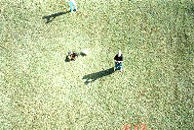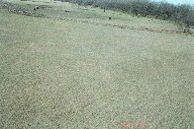

by Walter Anderson
Dallas, Texas, USA
My obsession with kite aerial photography began when I read the September 2000, Amateur Scientist column in Scientific American. This was the first time that I had even considered the possibility that a kite could lift a camera! A little research on the internet soon turned up a number of web sites with more information that I could have hoped for. P>As an amateur photographer I already owned several cameras, two Pentax ZX-M's and a Calumet Cadet 4x5. Despite what I had read about people using large 35mm SLR's I just didn't believe that a kite could safely lift that much weight. This seemed like a good excuse to buy a small point and shoot camera. I finally settled upon the Olympus Stylus Epic--since it appeared to be the lightest 35mm on the market.
The choice of kite proved to be much more difficult for me. It seemed like every site on the web had a different favorite. After much reading there appeared to be three styles dominating the field, parafoils, deltas (including Delta-Coynes), and Rokakus. Since my only experience with flying kites was the standard diamond shape as a child--unsuccessfully as I remember. I decided to purchase a small Sutton flow-form (4 sq. ft.) as a test to see if I could develop the skill to keep a kite in the air.
My initial trial with this kite was so successful that I ordered a Parafoil 17 from Into The Wind. I chose this over the Sutton Flow Form 16 because it had an extra 1 square foot of area for the same price! I know that this probably didn't make a difference but I was still worried that a Kite could provide enough lift to get a camera in the air. My next step was to construct a cradle to hold the camera.
By this time it was almost Thanksgiving (2000) and my mother was sick and requested that I come to visit. In talking with her I mentioned this whole KAP thing and she told me about how she used to love flying kites with her father. It seems that during the Depression he would make kites from newspaper and thin tree branches and take her out to fly kites. Since she was not expected to live much longer I took the small Sutton Flow-Form with me to Florida and took her to the park to fly the kite. The pictures I took of her smiling and laughing will remain among my favorites of her. I mention this part of the story because I think this would be a great activity for anyone who deals with the elderly. I know my mother enjoyed it and she was seventy years old at the time.
Anyway this whole KAP thing was put on hold until mid 2001 when I finally had some time to begin building the cradle. I have built many things out of wood over the years (including a camera); however, wood did not seem to have the strength to weight ratio that would be necessary. The most common cradle building material seemed to be aluminum. At this point the only metal working experience that I had was constructing a simple shutter for the camera that I mentioned earlier. That had proved to be an unpleasant affair!
I decided to bite the bullet, went to the local hardware store and purchased some aluminum stock (3/4" bar and 3/4" angle). I spent an entire weekend constructing the cross brace for the picavet suspension. The process was so frustrating that I didn't work on the cradle for another six months! In fact I had all but given up on the idea of flying a camera.
A serendipitous article I discovered while waiting for a hair cut in January was enough to rekindle my interest. It was an article in Popular Mechanics on the techniques for metalworking with hand tools. My previous attempts had been with only a hack saw and tin snips. This article discussed many things, including the importance of a fresh blade in the hack saw. Several other tools were mentioned and proved to make the difference. They were in order of importance nibbling tool ($10), center punch ($10), and a file ($5). In a couple of weekends these tools enabled me to construct a basic cradle using the standard U-shaped design.
I purchased a Futaba Attack-4 RC system, some gears and finished the cradle. I spent an entire weekend testing the functions and fine tuning the cradle. This cradle weighed in at about 900 grams or almost 2 pounds. In hindsight it was probably much sturdier than it should have been, but that turned out to be a good thing.
Since we had been getting relatively light winds (8-10 mph) I didn't believe that the Parafoil could lift such a heavy rig. I finally decided to bite the bullet and purchase the 13½ foot Sun Oaks Delta Coyne from Into The Wind. At the time I thought that this kite might be able to lift the rig.
I still had a few issues to work out before I flew the rig. With all of the information on KAP on the web I could not find any advice on two things. What kind of line (and how much) to use for the Picavet suspension and what knot to use to connect the two ends of the line in the Picavet. This would prove to be my undoing.
On the afternoon of February 23rd the conditions seemed ideal. The temperature was in the mid sixties, the winds were out of the south east at 12mph and there wasn't a cloud in the sky. I called a friend up and we headed off to a open area near my home. After some confusion, the kite assembly instructions for the DC are not for beginners, we managed to get the kite assembled. I was overjoyed when the kite practically leaped from my hand and rose to an altitude of about 150 feet. We flew the kite for awhile and were amazed with how stable it flew. When I was convinced that it wouldn't turn and head for the ground I decided to attach the camera rig.
It was here that my mistakes began to manifest. I'd decided to use butcher's twine for the rigging of the picavet. I made the further mistake of only using about twelve feet of line. This resulted in a very small suspension. My final error was in the knot I used to tie off the ends. The rig had barely left my hands when the knot came undone and the camera rig dropped about five feet to the ground.
After a moments inspection that the camera and electronics were okay, I retied the knots using two improved clinch knots. This seemed secure and the rig appeared to be working. The camera rig was sent aloft and a number of photographs were taken. Two of the best are shown below. A quick check of the camera indicated that I still had nine exposures left on the roll.
While my friend let line out to raise the camera I walked off to the side to get a better view and try for some good shots. As I turned around to face the camera I saw the rig fall from about 80-100 feet up! With resignation I walked over to the rig to survey the damage. To my surprise the camera and electronics appeared intact! The rig itself was a mangled mass of aluminum. We took the camera off of the rig and finished off the roll. The picture below shows me holding the kite as it was landed.
The post mortem on the rig confirmed that the camera and electronics survived the fall with only minor scratches! The over design of the rig had saved them. The rig itself was beyond repair. Most of the pieces were bent and twisted. The gears were sheared. In short it had flown its last. The post mortem revealed my errors; the butchers twine wasn't strong enough. It had abraded on the fishing swivels that I had used instead of pulleys. My biggest regret is that I never photographed the rig prior to its demise. No record of the Mark I will exist except for the sketch in my lab notebook!
I picked the photos up from the lab the next morning and I was hooked! Eighteen months after I began this project I had my first successful aerial photographs! Even if the next rig and camera get trashed I will persevere! I immediately began plans for the Mark II. The arrival of my copy of the Aerial Eye CD arrived in the mail that week and derailed my design plans. Volume 4, number 3 had a short article on an incredibly elegant cradle design--Brooks Leffler's Monopost III. There was sufficient detail that I wouldn't have to ad lib too much. Even better the rig was designed for my camera so I should be able to take measurements off of the diagrams for the parts!
I purchased the raw materials for the rig last week and spent this past weekend in the manufacture of the Monopost III (also known as the Mark II). While this rig is much lighter than my Mark I, I discovered during the first flight that I did not need to be as concerned about weight as I had thought. The 2 pound rig barely caused a bend in the line. The winds were fairly steady at 12mph, but even during a few brief lulls the camera drifted fairly slowly to the ground rather than the dead fall I would have expected.
To prevent the repeat of the last mishap I purchase a set of Pekabe pulleys to reduce wear on the suspension line. I also purchase 60 feet of Spectra bridle line to use instead of the Butcher's twine. I plan to test several knots this week to determine the best fit.
I would appreciate any input or advice from fellow travelers along the KAP path. I plan to follow-up this article with my experience with the Mark II rig (including photographs) in a week or two as weather and work permit.
This page and all of its contents are copyright 2002 by Walter Anderson
Return to the Home Page